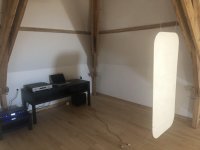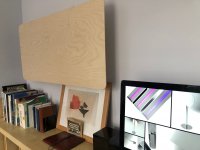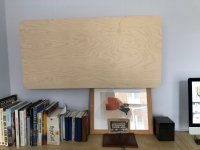This is a cheap version of a DML from a cheapo guy. Laugh if ya want but they do sound good! If I can master the bass cancellation from front/back I'll have a nice unit! They sound great outside.. More pics in the album.. ImageShack - Cheap DML Panel Speakers
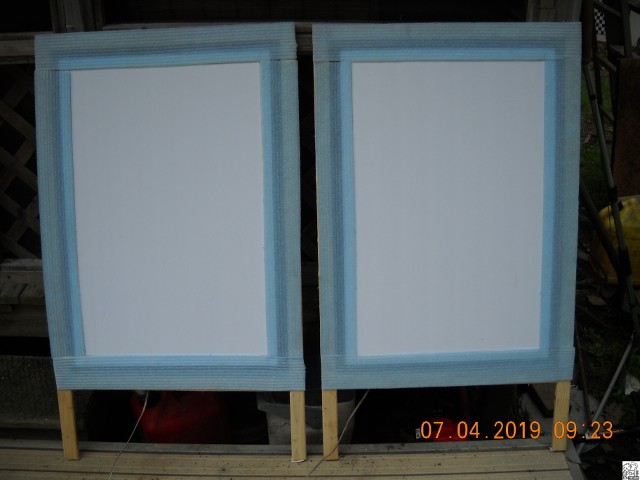

No ones laughing here. Looks great.
On bass cancellation DML’s are bipoles not dipoles so there is no front/back cancellation. I was getting down to 50hz on a cheapo spectrum analyser App but hearing deeper if you see what I mean. I am now running subs from 100hz down and to my surprise they integrate much better than I thought they would. The bass appears to be coming from the panels untill I stand really close to the sub.
On bass cancellation DML’s are bipoles not dipoles so there is no front/back cancellation. I was getting down to 50hz on a cheapo spectrum analyser App but hearing deeper if you see what I mean. I am now running subs from 100hz down and to my surprise they integrate much better than I thought they would. The bass appears to be coming from the panels untill I stand really close to the sub.
That's no surprise, the cues for bass are in the higher registers. Being closer to a wall may improve real low end end bass at the right distance. The question is about negative returns from the higher frequencies. Well and maybe WAF, if you could hang some panels in a regular room for music, they'd be pretty limited from distance to wall.
And now something completely different!
but not so much of topic.
Can I make an exciter from old (spare) speaker driver? How?
Or, why not?
Another option that I thought of, that is so blindingly obvious that someone has to have done it, is to just mount the driver in the foam board in the same manner in which you'd put it in an open baffle.
You'd have to use a small, light driver for the DML effect to set in at higher registers though. The small driver would also work somewhat like a tweeter and the board as and mechanical impedance converter.
Anything over a three inch driver would probably be too big (too much mass and too much directionality to merge with the DML effect).
Here is a nice diagram from deep in the thread.
It doesn't look right on the fixing between driver and panel.
Try lengthening the timber and using soft material to couple the panel. Keep the mounting points away from one another. Like the one on the right in my sketch. The driver itself and the panel should be supported separately.
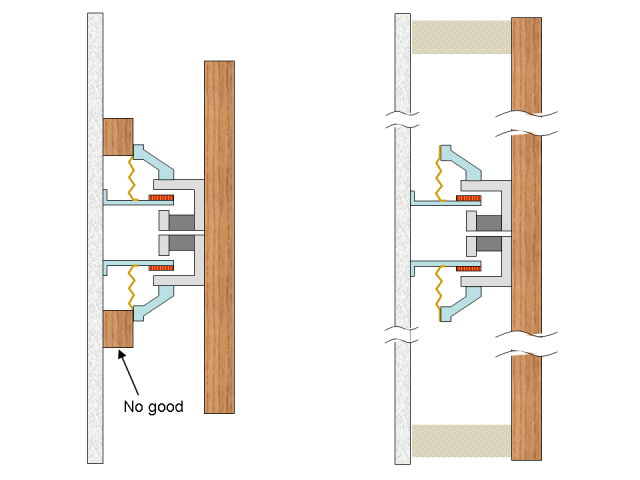
Or, if your driver can support itself, then ditch the wood blocks between frame and panel, and the timber. Then suspend the whole thing by other fixing points on the panel itself. By this, you support the panel only, and let the driver 'float' on it (by its own suspension).
And, your panels looks very near the wall and not much space around them. If they have to be that way, put some sound absorbing material between panels and wall to reduce reflections.
I haven't seen Tech Ingredients research videos on DMLs discussed here. Not really groundbreaking work, but he does have some interesting points and finds.
YouTube
YouTube
Anyone know what kind of exciter he uses?
Pretty fantastic channel with introductions to a lot of good stuff on the whole BTW.
He also has build of a TQWT Voigt pipe.
YouTube
YouTube
Anyone know what kind of exciter he uses?
Pretty fantastic channel with introductions to a lot of good stuff on the whole BTW.
He also has build of a TQWT Voigt pipe.
I have looked into panel speaker but have not created any yet.
I only read and heard approximations like 1:3 or 2:5 for the exciter position.
The exact/best position for the exciter on a panel very likely is 1: phi (1.608 golden ratio) or about 5:8. This will give the least panel resonances which are unwanted.
I only read and heard approximations like 1:3 or 2:5 for the exciter position.
The exact/best position for the exciter on a panel very likely is 1: phi (1.608 golden ratio) or about 5:8. This will give the least panel resonances which are unwanted.
Continuing the payback to this group after I have learnt so much from you all I have found a few points of interest from this paper
https://orca.cf.ac.uk/56177/1/U584947.pdf
“Distortion mechanisms in flat panel speakers have been explored by M. Colloms et al. [84] in a paper in 1998. Acoustic radiation from a Distributed Mode Loudspeaker (DML) results from low amplitude bending waves. Compared with the motor system of a pistonic driver, the DML exciter is of subtly different design and equivalent circuit with a different relationship to the radiating diaphragm. In this paper, loudspeaker distortions were reviewed, the equivalent circuits modelled and compared with the DML case, and the results for comparative measurements were presented. The investigation in this paper concluded that the distortion from DM panel speakers is significantly lower than equivalent piston/cone speakers, typically by lOdB.”
“As in the case of a conventional loudspeaker enclosure, the rear radiation may be a hindrance to the best performance of the DML system. The paper by Henry Azima et al. [87] investigated the unique behaviour of DMLs in closed enclosures of small dimension, offering analytical solutions leading to the prediction of the far-field pressure as well as the impedance response of the system supported by various measurements. It was observed that the change in system performance with varying enclosure volume was quite marked in the case where the depth is small compared with the panel dimensions. However, it was also shown that beyond a certain depth the increase in LF response become marginal. Another feature of a DML with a small enclosure was seen to be a significant improvement in the mid and high frequency response of the system.”
“In 2000 N. Harris et al [89] compared the acoustics of conventional, dipolar, and panel loudspeakers in the presence of a dominant specular reflection, using both measurement and numerical simulation. The degree of correlation between the direct and indirect sounds was investigated. The study confirmed that the DML sources produce reflections that are less correlated to the direct sound than those radiated from piston sources.”
“In 2000, James Angus [88] showed that a flat-frequency response in a DML is possible but only under certain conditions (Fig. 5.28) [88]. The paper showed that a combination of wave propagation mechanisms was responsible for DMLs broad frequency response. To achieve a flat frequency response was a challenge and 89 required careful design of a composite material overall bending modulus, core shear modulus, faceplate bending modulus, and thickness of the whole assembly”
For those thinking of building their own exciters I found this interesting
“A magnet of a certain polarization, when scaled down, exerts the same field at a distance reduced by the same amount as the magnet itself [1]. This phenomenon has important consequences since the conductor that interacts with the magnet experiences the same force as before because of the constant field. In addition, the current carrying conductors are more efficient in terms of heat dissipation when scaled down. The joule losses that heat up the conductors are proportional to the volume but the heat dissipation is proportional to the surface area, therefore when a conductor is scaled down, the heat generation to heat dissipation ratio decreases [1]. The decrease in heating results in the increase of current density of conductors within the admissible thermal limits. “
and
“It can be observed that the main magnetic interactions can benefit from a scale reduction. The chart also shows that in small-dimension devices, the most efficient magnetic interactions involve permanent magnets. The most important conclusions that can be derived from this interaction chart are that any electromagnetic device, having permanent magnets and interacting with currents, which is effective on a macroscopic scale remains as effective once miniaturized; interactions between permanent magnets are strongly improved by scale reduction and inductive effects are to be avoided.”
The paper includes a review of exciter design options and proposes a novel exciter design which it is claimed allows for multiple exciters to be combined to provide more bass and, with phase changes, allows ’steering’ of the output.
https://orca.cf.ac.uk/56177/1/U584947.pdf
“Distortion mechanisms in flat panel speakers have been explored by M. Colloms et al. [84] in a paper in 1998. Acoustic radiation from a Distributed Mode Loudspeaker (DML) results from low amplitude bending waves. Compared with the motor system of a pistonic driver, the DML exciter is of subtly different design and equivalent circuit with a different relationship to the radiating diaphragm. In this paper, loudspeaker distortions were reviewed, the equivalent circuits modelled and compared with the DML case, and the results for comparative measurements were presented. The investigation in this paper concluded that the distortion from DM panel speakers is significantly lower than equivalent piston/cone speakers, typically by lOdB.”
“As in the case of a conventional loudspeaker enclosure, the rear radiation may be a hindrance to the best performance of the DML system. The paper by Henry Azima et al. [87] investigated the unique behaviour of DMLs in closed enclosures of small dimension, offering analytical solutions leading to the prediction of the far-field pressure as well as the impedance response of the system supported by various measurements. It was observed that the change in system performance with varying enclosure volume was quite marked in the case where the depth is small compared with the panel dimensions. However, it was also shown that beyond a certain depth the increase in LF response become marginal. Another feature of a DML with a small enclosure was seen to be a significant improvement in the mid and high frequency response of the system.”
“In 2000 N. Harris et al [89] compared the acoustics of conventional, dipolar, and panel loudspeakers in the presence of a dominant specular reflection, using both measurement and numerical simulation. The degree of correlation between the direct and indirect sounds was investigated. The study confirmed that the DML sources produce reflections that are less correlated to the direct sound than those radiated from piston sources.”
“In 2000, James Angus [88] showed that a flat-frequency response in a DML is possible but only under certain conditions (Fig. 5.28) [88]. The paper showed that a combination of wave propagation mechanisms was responsible for DMLs broad frequency response. To achieve a flat frequency response was a challenge and 89 required careful design of a composite material overall bending modulus, core shear modulus, faceplate bending modulus, and thickness of the whole assembly”
For those thinking of building their own exciters I found this interesting
“A magnet of a certain polarization, when scaled down, exerts the same field at a distance reduced by the same amount as the magnet itself [1]. This phenomenon has important consequences since the conductor that interacts with the magnet experiences the same force as before because of the constant field. In addition, the current carrying conductors are more efficient in terms of heat dissipation when scaled down. The joule losses that heat up the conductors are proportional to the volume but the heat dissipation is proportional to the surface area, therefore when a conductor is scaled down, the heat generation to heat dissipation ratio decreases [1]. The decrease in heating results in the increase of current density of conductors within the admissible thermal limits. “
and
“It can be observed that the main magnetic interactions can benefit from a scale reduction. The chart also shows that in small-dimension devices, the most efficient magnetic interactions involve permanent magnets. The most important conclusions that can be derived from this interaction chart are that any electromagnetic device, having permanent magnets and interacting with currents, which is effective on a macroscopic scale remains as effective once miniaturized; interactions between permanent magnets are strongly improved by scale reduction and inductive effects are to be avoided.”
The paper includes a review of exciter design options and proposes a novel exciter design which it is claimed allows for multiple exciters to be combined to provide more bass and, with phase changes, allows ’steering’ of the output.
Hmmmm, not what I expected…
So I am back in the UK and I was keen to try another DML experiment at home.
I thought I would try a different exciter, the Tectonic TEAX32C20-8 32mm, because I was intrigued by its design. I am an industrial designer by training and I liked the dual ring attachment method. I also wanted to try out a higher quality ply, and, to compensate for the lower power of the Tectonic exciter compared to the Dayton Audio DAEX32EP-4 Thruster I had used in France, I went for a thinner board, 3mm. Also, because I had read that bass response could improved by placing the panel closer to the wall, I opted for hanging the panels closer to the rear wall. All of this had the additional benefit of giving the Panels a higher WAF.
Just about the only thing I did not change was the panel size, 1220mm by 615mm.
Soooo. I hooked it all up and…..got Mid-Fi at best.
The sound is compressed and peaks in the midrange. There are dynamics but a cartoonish cardboard cutout dynamics, not the dramatic richly timbral explosions of sound the panels in France had delivered. Detail was subdued, female voices were had a mlld nasal quality. Hmmmm.
Well it was my own damn fault, I had changed almost every element of the system other than the panel size.
I tried some severe EQ which helped but the detail loss and subdued dynamics remain. I am using way more EQ than the panels in France.
This is a shame as, given all the results reported using all sorts of exciters and all sorts of materials, I was beginning to think the DML system was very robust. Not true, implementation appears to be important.
I am going to do a rebuild next week using the same sort of cheap (very) ply stock I bought in France and I am going to order up some Dayton Thruster exciters so I can replicate the French system. I will let you now how that goes, but generalising from the result to date.
Thin boards don’t work as well as thicker boards
As the weight of the new panels are similar to the French panels that suggests material density is a critical factor
The thicker board is also stiffer- so high stiffness and low mass works best.
There may be a relationship. probably is, between exciter size and the energy it can impart and board size- all of the Pro-Audio panels use four exciters per panel.
Close to the wall is a problem, not an advantage, there is a lot of colouration introduced by close proximity to a wall. It might increase bass, it didn’t in this case, but I can’t live with the colouration.
I am not going to comment on the Tectonic exciter other than to say one of them appears to be developing distortion after barely five hours of use. I am not impressed with Tectonic’s QC but that doesn’t mean the design is wrong.
More news latter.
So I am back in the UK and I was keen to try another DML experiment at home.
I thought I would try a different exciter, the Tectonic TEAX32C20-8 32mm, because I was intrigued by its design. I am an industrial designer by training and I liked the dual ring attachment method. I also wanted to try out a higher quality ply, and, to compensate for the lower power of the Tectonic exciter compared to the Dayton Audio DAEX32EP-4 Thruster I had used in France, I went for a thinner board, 3mm. Also, because I had read that bass response could improved by placing the panel closer to the wall, I opted for hanging the panels closer to the rear wall. All of this had the additional benefit of giving the Panels a higher WAF.
Just about the only thing I did not change was the panel size, 1220mm by 615mm.
Soooo. I hooked it all up and…..got Mid-Fi at best.
The sound is compressed and peaks in the midrange. There are dynamics but a cartoonish cardboard cutout dynamics, not the dramatic richly timbral explosions of sound the panels in France had delivered. Detail was subdued, female voices were had a mlld nasal quality. Hmmmm.
Well it was my own damn fault, I had changed almost every element of the system other than the panel size.
I tried some severe EQ which helped but the detail loss and subdued dynamics remain. I am using way more EQ than the panels in France.
This is a shame as, given all the results reported using all sorts of exciters and all sorts of materials, I was beginning to think the DML system was very robust. Not true, implementation appears to be important.
I am going to do a rebuild next week using the same sort of cheap (very) ply stock I bought in France and I am going to order up some Dayton Thruster exciters so I can replicate the French system. I will let you now how that goes, but generalising from the result to date.
Thin boards don’t work as well as thicker boards
As the weight of the new panels are similar to the French panels that suggests material density is a critical factor
The thicker board is also stiffer- so high stiffness and low mass works best.
There may be a relationship. probably is, between exciter size and the energy it can impart and board size- all of the Pro-Audio panels use four exciters per panel.
Close to the wall is a problem, not an advantage, there is a lot of colouration introduced by close proximity to a wall. It might increase bass, it didn’t in this case, but I can’t live with the colouration.
I am not going to comment on the Tectonic exciter other than to say one of them appears to be developing distortion after barely five hours of use. I am not impressed with Tectonic’s QC but that doesn’t mean the design is wrong.
More news latter.
Far too many variables, I’m an idiot.
I will change one at a time when I make changes. I understand some have had success close to walls and I agree some absorption could help.
Xrk971 the material was 3mm Birch Ply normally used for Laser engraving. It was four or five times the price of the material I used in France. It’s certainly denser, which might be a problem rather than an advantage. I also am thinking the panel may be too big for the exciter. Pro-sound DML speakers have smaller and less dense panels with typically three or four exciters. I am just very surprised at the qualitative difference between my second build compared to my first.
I will change one at a time when I make changes. I understand some have had success close to walls and I agree some absorption could help.
Xrk971 the material was 3mm Birch Ply normally used for Laser engraving. It was four or five times the price of the material I used in France. It’s certainly denser, which might be a problem rather than an advantage. I also am thinking the panel may be too big for the exciter. Pro-sound DML speakers have smaller and less dense panels with typically three or four exciters. I am just very surprised at the qualitative difference between my second build compared to my first.
You and everyone here will learn a lot as you found out which variable does what.
Absorption material behind it will make it "think" that it's in a larger space. Basically you stop reflections that reinforce the movement and make it damped better - less sloppy. If you had it a distance from the wall that was specific to some bass frequencies it could reinforce them. But IMO any reinforced bass frequency also needs a damping element or it'll be meh.
Also you can reduce reflections. Reducing reflections is a mixed bag. When they're from a close source, they're often negative because they are too close to the original wave. If they are father away like in France they can add depth to the soundstage.
It's a guess that it might be possible to have them "basically mounted on the wall" if you can damp behind them very well. Using something like an SMT defuser as a wave guide to force the sound to the sides, as well as significant material similar to pillows might work very well. It might even be possible to tune it for great bass. Just guesses...
What do you think the distance from the wall would be for WAF acceptance?
Absorption material behind it will make it "think" that it's in a larger space. Basically you stop reflections that reinforce the movement and make it damped better - less sloppy. If you had it a distance from the wall that was specific to some bass frequencies it could reinforce them. But IMO any reinforced bass frequency also needs a damping element or it'll be meh.
Also you can reduce reflections. Reducing reflections is a mixed bag. When they're from a close source, they're often negative because they are too close to the original wave. If they are father away like in France they can add depth to the soundstage.
It's a guess that it might be possible to have them "basically mounted on the wall" if you can damp behind them very well. Using something like an SMT defuser as a wave guide to force the sound to the sides, as well as significant material similar to pillows might work very well. It might even be possible to tune it for great bass. Just guesses...
What do you think the distance from the wall would be for WAF acceptance?
Thanks Destroyer, I will report back warts and all.
On WAF I am sure that varies from wife to wife! I am getting away with the images attached. The panels are about 6 inches from the back wall.
I spent some more time last night EQing and setting up the subs which helped, however one new thing I have discovered this morning. There seems to be a minimal volume/energy level at play with this combination of exciter and board size. When played louder a lot of the colouration, in particular the nasality on female voices, disappears. I also get a better sense of timbre and dynamics. This is a speculation but I think the panels were not getting enough energy into them to allow a fully modal condition-just a guess but thats what I heard.
On WAF I am sure that varies from wife to wife! I am getting away with the images attached. The panels are about 6 inches from the back wall.
I spent some more time last night EQing and setting up the subs which helped, however one new thing I have discovered this morning. There seems to be a minimal volume/energy level at play with this combination of exciter and board size. When played louder a lot of the colouration, in particular the nasality on female voices, disappears. I also get a better sense of timbre and dynamics. This is a speculation but I think the panels were not getting enough energy into them to allow a fully modal condition-just a guess but thats what I heard.
Attachments
Hmmmm, not what I expected…
So I am back in the UK and I was keen to try another DML experiment at home.
I thought I would try a different exciter, the Tectonic TEAX32C20-8 32mm, because I was intrigued by its design. I am an industrial designer by training and I liked the dual ring attachment method. I also wanted to try out a higher quality ply, and, to compensate for the lower power of the Tectonic exciter compared to the Dayton Audio DAEX32EP-4 Thruster I had used in France, I went for a thinner board, 3mm. Also, because I had read that bass response could improved by placing the panel closer to the wall, I opted for hanging the panels closer to the rear wall. All of this had the additional benefit of giving the Panels a higher WAF.
Just about the only thing I did not change was the panel size, 1220mm by 615mm.
Soooo. I hooked it all up and…..got Mid-Fi at best.
The sound is compressed and peaks in the midrange. There are dynamics but a cartoonish cardboard cutout dynamics, not the dramatic richly timbral explosions of sound the panels in France had delivered. Detail was subdued, female voices were had a mlld nasal quality. Hmmmm.
Well it was my own damn fault, I had changed almost every element of the system other than the panel size.
I tried some severe EQ which helped but the detail loss and subdued dynamics remain. I am using way more EQ than the panels in France.
This is a shame as, given all the results reported using all sorts of exciters and all sorts of materials, I was beginning to think the DML system was very robust. Not true, implementation appears to be important.
I am going to do a rebuild next week using the same sort of cheap (very) ply stock I bought in France and I am going to order up some Dayton Thruster exciters so I can replicate the French system. I will let you now how that goes, but generalising from the result to date.
Thin boards don’t work as well as thicker boards
As the weight of the new panels are similar to the French panels that suggests material density is a critical factor
The thicker board is also stiffer- so high stiffness and low mass works best.
There may be a relationship. probably is, between exciter size and the energy it can impart and board size- all of the Pro-Audio panels use four exciters per panel.
Close to the wall is a problem, not an advantage, there is a lot of colouration introduced by close proximity to a wall. It might increase bass, it didn’t in this case, but I can’t live with the colouration.
I am not going to comment on the Tectonic exciter other than to say one of them appears to be developing distortion after barely five hours of use. I am not impressed with Tectonic’s QC but that doesn’t mean the design is wrong.
More news latter.
Right off the bat I already know your main problem effecting your panels which is (believe it or not) the extra ring of attachment on that particular type of exciter. This extra ring of attachment is basically like the exciters utilizing the so called "LEGS", for extra support but the down fall is those legs or extra attachment supports actually reduce vibrations. The only part of the exciter that should be touching the panel material is the exciters voice coil and nothing else.
If you do decide to take my advice you can easily remove and peel of the ring foam with your hands. If you happen to have or buy the exciters with legs they can easily be removed with a decent pair of scissors.
Also panels should be at least 2ft. away from the back walls.
Last edited:
- Home
- Loudspeakers
- Full Range
- A Study of DMLs as a Full Range Speaker
